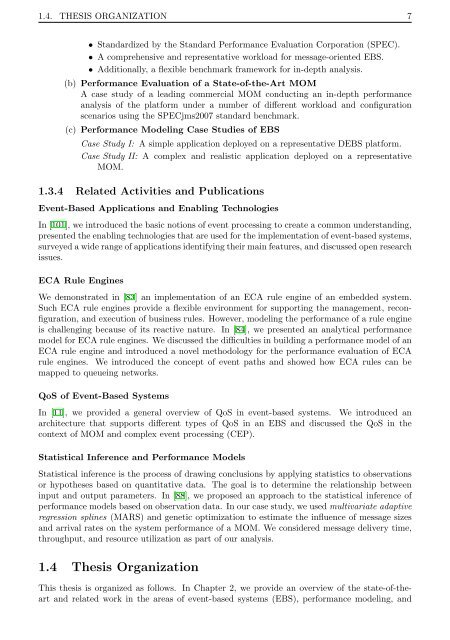Performance Modeling and Benchmarking of Event-Based ... - DVS
Performance Modeling and Benchmarking of Event-Based ... - DVS
Performance Modeling and Benchmarking of Event-Based ... - DVS
You also want an ePaper? Increase the reach of your titles
YUMPU automatically turns print PDFs into web optimized ePapers that Google loves.
1.4. THESIS ORGANIZATION 7<br />
• St<strong>and</strong>ardized by the St<strong>and</strong>ard <strong>Performance</strong> Evaluation Corporation (SPEC).<br />
• A comprehensive <strong>and</strong> representative workload for message-oriented EBS.<br />
• Additionally, a flexible benchmark framework for in-depth analysis.<br />
(b) <strong>Performance</strong> Evaluation <strong>of</strong> a State-<strong>of</strong>-the-Art MOM<br />
A case study <strong>of</strong> a leading commercial MOM conducting an in-depth performance<br />
analysis <strong>of</strong> the platform under a number <strong>of</strong> different workload <strong>and</strong> configuration<br />
scenarios using the SPECjms2007 st<strong>and</strong>ard benchmark.<br />
(c) <strong>Performance</strong> <strong>Modeling</strong> Case Studies <strong>of</strong> EBS<br />
Case Study I: A simple application deployed on a representative DEBS platform.<br />
Case Study II: A complex <strong>and</strong> realistic application deployed on a representative<br />
MOM.<br />
1.3.4 Related Activities <strong>and</strong> Publications<br />
<strong>Event</strong>-<strong>Based</strong> Applications <strong>and</strong> Enabling Technologies<br />
In [101], we introduced the basic notions <strong>of</strong> event processing to create a common underst<strong>and</strong>ing,<br />
presented the enabling technologies that are used for the implementation <strong>of</strong> event-based systems,<br />
surveyed a wide range <strong>of</strong> applications identifying their main features, <strong>and</strong> discussed open research<br />
issues.<br />
ECA Rule Engines<br />
We demonstrated in [83] an implementation <strong>of</strong> an ECA rule engine <strong>of</strong> an embedded system.<br />
Such ECA rule engines provide a flexible environment for supporting the management, reconfiguration,<br />
<strong>and</strong> execution <strong>of</strong> business rules. However, modeling the performance <strong>of</strong> a rule engine<br />
is challenging because <strong>of</strong> its reactive nature. In [84], we presented an analytical performance<br />
model for ECA rule engines. We discussed the difficulties in building a performance model <strong>of</strong> an<br />
ECA rule engine <strong>and</strong> introduced a novel methodology for the performance evaluation <strong>of</strong> ECA<br />
rule engines. We introduced the concept <strong>of</strong> event paths <strong>and</strong> showed how ECA rules can be<br />
mapped to queueing networks.<br />
QoS <strong>of</strong> <strong>Event</strong>-<strong>Based</strong> Systems<br />
In [11], we provided a general overview <strong>of</strong> QoS in event-based systems. We introduced an<br />
architecture that supports different types <strong>of</strong> QoS in an EBS <strong>and</strong> discussed the QoS in the<br />
context <strong>of</strong> MOM <strong>and</strong> complex event processing (CEP).<br />
Statistical Inference <strong>and</strong> <strong>Performance</strong> Models<br />
Statistical inference is the process <strong>of</strong> drawing conclusions by applying statistics to observations<br />
or hypotheses based on quantitative data. The goal is to determine the relationship between<br />
input <strong>and</strong> output parameters. In [88], we proposed an approach to the statistical inference <strong>of</strong><br />
performance models based on observation data. In our case study, we used multivariate adaptive<br />
regression splines (MARS) <strong>and</strong> genetic optimization to estimate the influence <strong>of</strong> message sizes<br />
<strong>and</strong> arrival rates on the system performance <strong>of</strong> a MOM. We considered message delivery time,<br />
throughput, <strong>and</strong> resource utilization as part <strong>of</strong> our analysis.<br />
1.4 Thesis Organization<br />
This thesis is organized as follows. In Chapter 2, we provide an overview <strong>of</strong> the state-<strong>of</strong>-theart<br />
<strong>and</strong> related work in the areas <strong>of</strong> event-based systems (EBS), performance modeling, <strong>and</strong>















